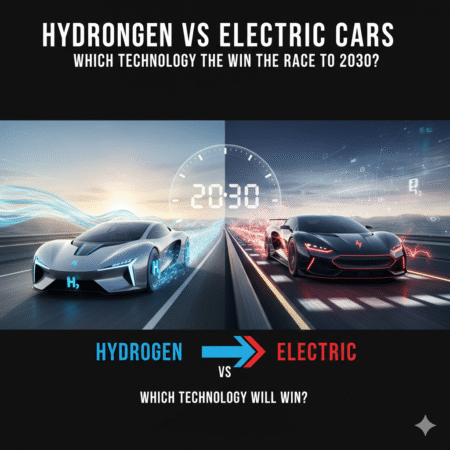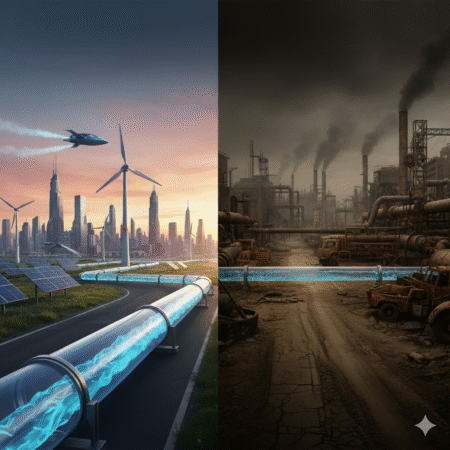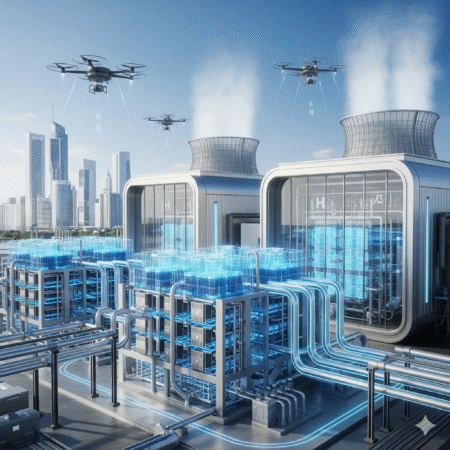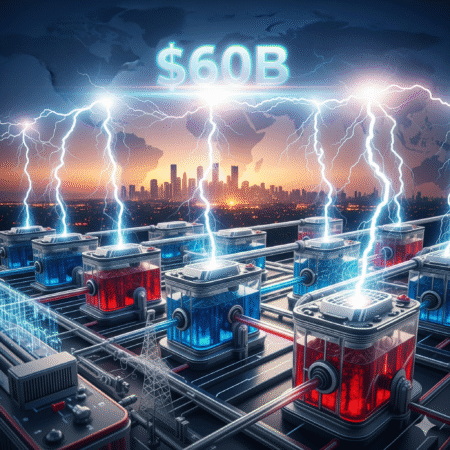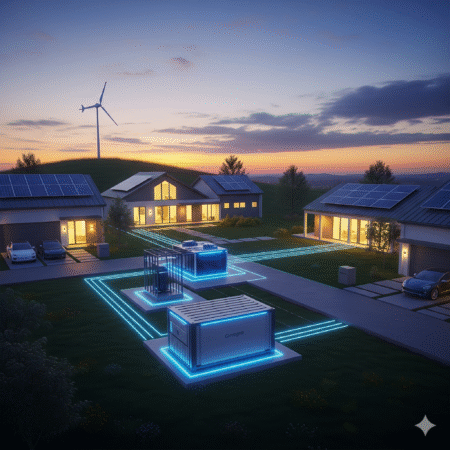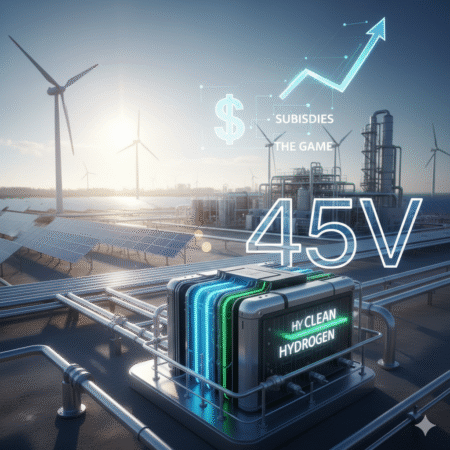
- Introduction – The Transport Decarbonization Dilemma
- How Battery Electric Vehicles (BEVs) Work
- How Hydrogen Fuel Cell Vehicles (FCEVs) Work
- The Bottom Line
- Hydrogen vs Batteries: Key Comparison
- Cost Battle: Who’s Cheaper Today and Tomorrow?
- Real-World Adoption: Who’s Betting on What?
- The Road to 2030: Who’s Likely to Win?
- FAQ + Conclusion + CTA
Introduction – The Transport Decarbonization Dilemma
If you think the EV (electric vehicle) revolution is already won by batteries, think again. Yes, Tesla, BYD, and countless EV startups have made batteries the poster child of clean transport. But in the background, hydrogen is quietly gaining traction – and many experts believe it could be the dark horse of the mobility race.
Here’s the truth:
- Transport is responsible for ~25% of global CO₂ emissions (IEA, 2023).
- Passenger cars are shifting rapidly to electric batteries.
- But for trucks, buses, ships, and planes? Batteries alone might not cut it. That’s where hydrogen steps in.
The real question isn’t “Will hydrogen replace batteries?” but rather “Where will each technology dominate by 2030?”
Why the Race Is Heating Up
Governments worldwide have set net-zero targets. That means one thing: fossil-fuel-powered cars and trucks are living on borrowed time.
- The US is pouring billions into EV subsidies through the Inflation Reduction Act.
- The EU has banned sales of new combustion cars from 2035.
- Japan and South Korea are betting heavily on hydrogen to power both cars and heavy industries.
This isn’t just about cleaner air – it’s about who controls the future of mobility.
Batteries Dominate Today, But Hydrogen Is Catching Up
Right now, batteries have the edge: lower costs, expanding infrastructure, and strong consumer adoption. But hydrogen offers what batteries can’t: fast refueling, longer ranges, and suitability for heavy-duty transport.
To set the stage, here’s a quick snapshot of why the “hydrogen vs battery” debate matters:
| Question | Batteries (BEVs) | Hydrogen (FCEVs) |
|---|---|---|
| Who dominates passenger cars? | ✅ Already leading globally | 🚫 Still niche |
| Who powers heavy trucks best? | ⚠ Limited due to battery size | ✅ Hydrogen shows promise |
| Who’s winning on cost today? | ✅ Batteries are cheaper | 🚫 Hydrogen is still costly |
| Who’s faster to refuel? | ❌ Slower (30–60 mins) | ✅ Refuels in 3–5 mins |
What This Battle Means for the Future of Mobility
The outcome of this rivalry will reshape industries worth trillions of dollars:
- Oil & gas companies are reinventing themselves as hydrogen suppliers.
- Auto giants are split: Tesla bets everything on batteries, while Toyota pushes hydrogen.
- Policy makers are hedging their bets – subsidies are going into both.
By 2030, you won’t be asking “hydrogen or battery?” The smarter question will be:
“Which technology powers which type of vehicle?”
That sets the stage. In the next section, we’ll break down how batteries work – and why they’ve become the current king of clean transport.
How Battery Electric Vehicles (BEVs) Work
When you think of clean transport, chances are the first image that pops into your head is a Tesla Model 3 silently cruising down the highway. That’s no accident – battery electric vehicles (BEVs) have become the poster child of decarbonized mobility. But why exactly are they winning the spotlight today? Let’s break it down.
The Simple Yet Powerful BEV Architecture
Unlike traditional cars with hundreds of moving parts – engines, pistons, transmissions, exhaust systems – BEVs are beautifully simple.
At their core, BEVs consist of:
- Battery Pack – The “fuel tank” storing electricity, usually lithium-ion.
- Inverter – Converts direct current (DC) from the battery into alternating current (AC) for the motor.
- Electric Motor – Turns electricity into motion, spinning the wheels.
- Onboard Charger + Software – Manages charging, efficiency, and regenerative braking.
This simplicity is a game-changer. Fewer moving parts mean lower maintenance costs, fewer breakdowns, and smoother driving.
Why BEVs Dominate Passenger Cars Today
If we look at the numbers, the BEV story gets even stronger:
- Global sales of EVs surpassed 14 million in 2023 (IEA), up 35% from 2022.
- China leads the market, with 1 in 3 new cars sold being electric.
- Battery costs have fallen by ~89% since 2010 (BloombergNEF).
It’s no surprise that BEVs are dominating passenger cars and urban mobility. The economics make sense, and the infrastructure is catching up.
Key Benefits Driving BEV Growth
So why are consumers, governments, and automakers doubling down on batteries? Here are the big three reasons:
- High Energy Efficiency – BEVs convert about 70–80% of grid electricity into wheel power. Compare that to internal combustion engines at just 20–25%.
- Infrastructure Growth – Charging stations are multiplying fast. In the US alone, public chargers grew 40% YoY in 2023.
- Consumer Adoption & Trust – EVs are now mainstream, no longer just a niche for early adopters.
Quick Snapshot: Why BEVs Are Winning (For Now)
| Factor | BEVs (Battery Electric Vehicles) | Why It Matters |
|---|---|---|
| Architecture | Simple: battery + motor + inverter | Fewer parts, less maintenance |
| Efficiency | ~70–80% | More miles per unit of energy |
| Charging Infrastructure | Expanding rapidly worldwide | Convenience drives adoption |
| Market Penetration | 14M+ units sold in 2023 | Strong consumer acceptance |
| Best Use Case | Passenger cars, city transport, short-to-medium range | Where BEVs shine the most |
The Catch: Where BEVs Struggle
But let’s keep it real. BEVs aren’t perfect. While great for daily commutes and passenger cars, challenges remain:
- Charging Time – Even fast chargers take 30–60 minutes for a full charge.
- Range Anxiety – Although ranges of 400–500 km are common, it’s still a concern for long-haul driving.
- Battery Supply Chain – Mining lithium, cobalt, and nickel comes with environmental and geopolitical challenges.
This is exactly where hydrogen sees an opening – not to replace batteries, but to complement them in sectors where batteries hit their limits.
How Hydrogen Fuel Cell Vehicles (FCEVs) Work
If you’ve ever been stuck at a gas station for 5 minutes filling up your car, imagine this: you walk into the future, and instead of gasoline, you’re pumping hydrogen. Five minutes later, your tank is full, and you’re driving another 600+ km with zero emissions from your tailpipe. That’s the magic hydrogen fuel cell vehicles (FCEVs) promise.
But here’s the catch: while FCEVs sound futuristic, the technology has been around for decades. NASA used hydrogen fuel cells to power the Apollo missions back in the 1960s. Today, the race is about scaling that tech for cars, buses, and trucks. Let’s unpack how it works and why it matters.
The Science Made Simple: How FCEVs Run
At the heart of every FCEV is the fuel cell stack, a system that turns hydrogen into electricity. Here’s the simple breakdown:
- Hydrogen Storage Tank – Pressurized hydrogen gas is stored in a tank.
- Fuel Cell Stack – Hydrogen enters the stack, where it meets oxygen from the air. Through an electrochemical reaction, electrons are released.
- Electric Motor – The electrons power an electric motor, which drives the vehicle.
- Water Vapor Emission – The only byproduct is pure water vapor.
So in short: H₂ + O₂ → Electricity + H₂O. No smoke. No CO₂. Just clean power.
Why Hydrogen Works Best for Heavy Transport
FCEVs aren’t trying to replace battery EVs in passenger cars (at least not yet). Instead, their sweet spot is heavy-duty mobility:
- Long-haul trucks that need 600–1,000 km range without long charging stops.
- Public buses that can refuel quickly and stay on the road.
- Industrial fleets like forklifts or shipping equipment where downtime is costly.
That’s why companies like Hyundai (XCIENT Fuel Cell trucks) and Toyota (Mirai, hydrogen buses) are putting their chips on hydrogen.
The Big Benefits of FCEVs
- Fast Refueling – Takes 3–5 minutes, just like gasoline.
- Long Range – Typically 600 km+, making them ideal for logistics and intercity transport.
- Clean at the Tailpipe – The only emission is water vapor.
Quick Comparison Snapshot: BEVs vs FCEVs
| Factor | BEVs (Battery Electric Vehicles) | FCEVs (Fuel Cell Vehicles) |
|---|---|---|
| Refueling/Charging | 30–60 minutes (fast charging) | 3–5 minutes |
| Driving Range | 300–500 km | 600–1,000 km |
| Best For | Cars, city driving | Trucks, buses, heavy transport |
| Infrastructure | Rapidly expanding globally | Still in early stages, very limited |
The Challenges Holding FCEVs Back
Of course, hydrogen isn’t a silver bullet. There are serious roadblocks:
- Infrastructure Gap – Hydrogen refueling stations are scarce. For example, California has ~55 hydrogen stations vs tens of thousands of EV chargers.
- Energy Efficiency – Converting renewable power into hydrogen, then back to electricity, wastes energy compared to batteries.
- Cost – Hydrogen production and storage remain expensive, though costs are falling as green hydrogen scales.
The Bottom Line
FCEVs aren’t here to kill electric cars – they’re here to fill the gaps batteries can’t. Think of BEVs as the everyday city runner and FCEVs as the long-distance marathoner. Together, they create a transport ecosystem where clean energy covers all use cases.
Hydrogen vs Batteries: Key Comparison
Let’s be real: when people talk about hydrogen vs electric, they often throw around buzzwords without context. “Hydrogen is the fuel of the future.” Or, “Batteries already won.”
The truth? Both sides have strengths and weaknesses. If you’re thinking about where the market is headed, you need to understand the hard numbers and real-world trade-offs.
Read More: Hydrogen Is the New Oil? How Industrial Giants Are Racing to Go Green
Imagine this: you’re running a logistics fleet in Los Angeles. Do you choose battery trucks that need 45 minutes of charging per trip, or hydrogen trucks that can refuel in 5 minutes but rely on scarce fueling stations? The choice isn’t philosophical-it’s operational.
Here’s the breakdown:
Efficiency: Who Wastes Less Energy?
- Batteries (BEVs): Super efficient. 70–80% of the energy stored makes it to the wheels.
- Hydrogen (FCEVs): Less efficient-only ~30–40% gets to the wheels, since energy is lost during electrolysis, compression, and conversion in the fuel cell.
Verdict: If you’re chasing efficiency, BEVs win by a mile.
Refueling & Charging Time
- BEVs: Even with fast chargers, expect 30–60 minutes for a full charge.
- FCEVs: Refueling is quick-around 3–5 minutes, like filling up gasoline.
Verdict: For fleets or long-distance travel, hydrogen wins here.
Range & Use Cases
- BEVs: Great for personal cars and city transport. 300–500 km is typical, with some premium EVs pushing higher.
- FCEVs: Can achieve 600+ km, making them attractive for trucks, buses, and heavy-duty vehicles.
Verdict: Hydrogen dominates heavy transport, but batteries are ideal for daily commutes.
Infrastructure Reality
- Batteries: Charging stations are popping up everywhere-from malls to gas stations.
- Hydrogen: Still limited. In California, you’ll find fewer than 70 public stations compared to thousands of EV chargers.
Verdict: BEVs have the clear edge today, though hydrogen networks are slowly expanding.
Quick Comparison Table
| Factor | Batteries (BEVs) | Hydrogen (FCEVs) |
|---|---|---|
| Efficiency | High (~70–80%) | Lower (~30–40%) |
| Refueling Time | 30–60 min (fast charging) | 3–5 min |
| Range | 300–500 km | 600+ km possible |
| Infrastructure | Growing rapidly | Still very limited |
| Best Fit | Cars, city EVs | Trucks, buses, industry |
Bottom Line
If you’re a consumer-stick with BEVs. Cheaper, efficient, and infrastructure is everywhere.
If you’re in heavy logistics or industrial transport-hydrogen could be your game-changer, provided governments and energy companies build the fueling backbone.
So, the winner? It depends on what wheels you’re driving.
Cost Battle: Who’s Cheaper Today and Tomorrow?
When it comes to clean transport, money talks louder than technology. People don’t just ask, “Is it green?” They ask, “Can I afford it?”
Here’s the truth: whether hydrogen or electric wins in 2030 depends as much on economics as on engineering. And right now, the cost curve is very different for both technologies.
Battery Costs: Dropping Like a Rock
- In 2010, lithium-ion batteries cost more than $1,000 per kWh.
- By 2023, they dropped below $140 per kWh, and BloombergNEF predicts they’ll fall to $60–80 per kWh by 2030.
- Translation? EVs are getting cheaper every year, making them more competitive with gasoline cars.
For consumers, this means the upfront cost gap is closing fast.
Hydrogen Costs: Expensive… But Falling
- Producing hydrogen today (especially green hydrogen) costs $5–7 per kg.
- That’s pricey when you realize a fuel-cell car needs ~1 kg of H₂ to drive 100 km.
- But here’s the catch: with scale and renewable energy, costs could drop to $1–2 per kg by 2030, making hydrogen competitive with diesel for trucks.
For heavy transport, hydrogen’s future looks promising-if governments and industry scale production.
The Policy Factor: Subsidies Shape the Game
It’s not just about technology-it’s about politics and policy.
- EVs: Governments everywhere are pouring money into tax credits, charging networks, and purchase incentives.
- Hydrogen: The US Inflation Reduction Act gives up to $3/kg tax credit for green H₂ production, while the EU is funding hydrogen corridors for trucks.
The one who gets more policy support per sector will scale faster.
Cost Comparison Table
| Factor | Batteries (BEVs) | Hydrogen (FCEVs) |
|---|---|---|
| Vehicle Price (2025) | $35,000–$50,000 (mid-range EVs) | $50,000–$70,000 (Toyota Mirai, Hyundai Nexo) |
| Fuel/Energy Cost | ~$0.04–0.06 per km (cheap electricity) | ~$0.10–0.15 per km (current H₂ prices) |
| Cost Trend 2030 | Falling (battery <$80/kWh) | Falling (green H₂ $1–2/kg possible) |
| Best Fit Economically | Passenger cars, city use | Long-haul trucks, buses, industrial fleets |
Bottom Line
If you’re a consumer buying a family car, batteries are already cheaper and will only get cheaper.
If you’re running a logistics company or a fleet of buses, hydrogen could soon compete on cost-especially with subsidies and falling production prices.
The big question isn’t just “which is cheaper?” but “who will scale faster to push costs even lower?”
And right now, batteries are winning the cost race, but hydrogen is preparing its comeback in heavy-duty markets.
Real-World Adoption: Who’s Betting on What?
Here’s the reality: technology alone doesn’t win. Adoption does.
The big question isn’t just which is better? but who’s actually putting their money, factories, and fleets on the line?
And today, the battlefield looks like this: EVs dominate the consumer space, while hydrogen is quietly gaining ground in commercial and industrial transport. Let’s break it down.
Tesla, BYD, and the All-In EV Strategy
- Tesla isn’t just building cars-it’s building a charging empire. With over 55,000 Superchargers worldwide (2025), it’s making EV adoption seamless.
- BYD (China’s EV giant) is producing millions of electric cars annually, exporting aggressively to Europe.
- Their bet is simple: scale fast, drive costs down, and make batteries the default choice for passenger cars.
They’re not touching hydrogen-because they believe BEVs are already winning the consumer market.
Toyota & Hyundai: Betting Big on Hydrogen
On the other side, you’ve got the hydrogen champions.
- Toyota launched the Mirai back in 2014 and keeps doubling down despite slow sales. Why? They see hydrogen as the only scalable solution for trucks, buses, and even shipping.
- Hyundai is betting on hydrogen trucks (the Xcient Fuel Cell) already deployed in Switzerland and expanding across Europe.
- Both believe that batteries alone can’t handle long-haul transport.
Their message: EVs are great for cities, hydrogen is essential for heavy duty.
Governments: Playing Both Sides
- United States: The Inflation Reduction Act (IRA) supports both EV tax credits and $3/kg hydrogen production subsidies.
- European Union: Building a hydrogen corridor for trucks while also requiring every new car sold by 2035 to be zero-emission.
- Japan & South Korea: Pioneering hydrogen roadmaps, investing billions in hydrogen stations and R&D.
Policies show this isn’t a “winner takes all” race. Governments know they need both solutions.
Who’s Betting on What?
| Player | Technology Bet | Focus Area |
|---|---|---|
| Tesla, BYD | Battery (BEVs) | Passenger cars, urban transport |
| Toyota, Hyundai | Hydrogen (FCEVs) | Long-haul trucks, buses, fuel cell cars |
| US & EU Governments | Both | EV subsidies + hydrogen infrastructure |
| Japan, South Korea | Hydrogen-heavy | Stations, shipping, trucks, energy mix |
Bottom Line
If you’re looking at the scoreboard today, EVs are far ahead-millions of cars sold, charging stations everywhere, strong consumer demand.
But behind the scenes, hydrogen is building momentum in the niches batteries can’t dominate: long-haul, industrial, shipping.
The smart money? Don’t think of it as EV versus hydrogen. Think of it as EV plus hydrogen. Both are carving their turf, and both will be needed to hit net-zero targets.
The Road to 2030: Who’s Likely to Win?
Let’s be honest-2030 isn’t far away. In less than 7 years, the car you buy, the truck delivering your Amazon order, and even the bus you ride could be running on either batteries or hydrogen fuel cells.
So, who’s going to dominate the roads?
Here’s the catch: the race isn’t just about technology. It’s about cost curves, infrastructure rollouts, and government policies. And right now, the numbers are starting to paint a very clear picture.
EVs: The Passenger Market Powerhouse
According to the IEA (International Energy Agency), battery electric vehicles (BEVs) could make up 60% of new car sales by 2030, driven by falling battery costs and massive charging network expansion.
Why?
- Battery prices have dropped from $1,200/kWh in 2010 to ~$130/kWh in 2024 (BNEF data).
- By 2030, they could hit $70/kWh-the holy grail for EV cost parity with gasoline cars.
- Charging stations are multiplying: Europe alone aims for 3 million public chargers by 2030.
Bottom line: EVs are almost guaranteed to dominate passenger cars, SUVs, and city transport.
Hydrogen: The Heavyweight Contender
But here’s where hydrogen sneaks in. Batteries struggle when you need:
- Long range (600+ km without downtime)
- Fast refueling (minutes, not hours)
- Heavy loads (trucks, buses, ships, planes)
This is where hydrogen fuel cells shine.
BNEF forecasts that by 2030:
- Hydrogen trucks could account for 15–20% of new heavy-duty vehicle sales in key markets (EU, South Korea, Japan).
- The cost of green hydrogen could fall below $2/kg in regions like the Middle East, Australia, and US-making it competitive with diesel.
Translation: Hydrogen isn’t chasing Tesla-it’s building its own lane in long-haul and industrial transport.
Who Wins What by 2030?
| Segment | Likely Winner | Why It Wins |
|---|---|---|
| Passenger Cars | EVs | Lower cost, stronger infrastructure, efficiency |
| City Buses | Both | EV for urban routes, H₂ for long-distance buses |
| Long-Haul Trucks | Hydrogen | Fast refueling, heavy load capacity |
| Shipping & Aviation | Hydrogen/Derivatives | Batteries impractical; H₂ & e-fuels take over |
| Industrial Fleets | Hydrogen | Steel, cement, mining need hydrogen power |
Final Verdict: Not Either/Or, But Both/And
By 2030, expect streets filled with EVs while hydrogen dominates behind-the-scenes transport-the trucks, buses, ships, and factories that keep economies moving.
Governments and companies aren’t betting on one horse. They’re building dual ecosystems, because the world simply can’t hit net-zero by 2050 without both batteries and hydrogen.
The real winners? Consumers, cities, and industries that get cleaner, faster, and cheaper transport options.
FAQ + Conclusion + CTA
Frequently Asked Questions (FAQ)
Let’s be real. Whenever the “hydrogen vs EV” debate comes up, the same questions always surface. Let’s tackle them one by one.
- Are hydrogen cars safe?
Yes. Hydrogen has a reputation as “explosive,” thanks to movies and the Hindenburg disaster. But modern hydrogen fuel tanks are built from carbon fiber, rigorously tested under crash conditions, and even vent hydrogen safely in case of leaks. In many tests, hydrogen cars are as safe-or safer-than gasoline vehicles. - Will hydrogen cars be available everywhere by 2030?
Not quite. EV chargers are exploding in number, while hydrogen stations are growing slowly. Expect FCEVs to be concentrated in hubs-think California, Germany, Japan, and South Korea-where governments are heavily subsidizing infrastructure. - What about resale value?
For now, BEVs are winning because they’re mainstream. Hydrogen resale values are uncertain since the market is small. However, as heavy transport fleets adopt hydrogen (trucks, buses), the second-hand market for fuel cell systems may grow. - Which is more eco-friendly: EVs or hydrogen cars?
It depends on how the energy is made. An EV powered by coal-based electricity is dirtier than a hydrogen car powered by green H₂. Conversely, an EV running on solar-charged batteries beats hydrogen produced from fossil fuels. Bottom line: the source of energy matters more than the vehicle type.
Conclusion: It’s Not EVs vs Hydrogen-It’s EVs and Hydrogen
Here’s the truth: the future of clean transport isn’t a winner-takes-all race.
- BEVs will dominate passenger cars thanks to efficiency, affordability, and fast-charging networks.
- Hydrogen FCEVs will shine in long-haul trucking, buses, and heavy-duty transport, where batteries struggle with weight and range.
Instead of fighting, these two technologies will coexist, serving different needs just like airplanes didn’t kill trains, and trains didn’t kill cars.
By 2030, expect to see EVs filling city streets while hydrogen powers fleets of trucks, buses, and even ships. The real winner? Consumers and the planet.
Quick Recap: Who Wins Where?
| Segment | Battery EVs (BEVs) | Hydrogen FCEVs |
|---|---|---|
| Passenger cars | ✅ Best choice | ❌ Niche only |
| City buses | ✅ Works well | ✅ Strong case |
| Long-haul trucks | ❌ Heavy battery | ✅ Strong case |
| Shipping & aviation | ❌ Not viable yet | ✅ Promising |
| Infrastructure pace | ✅ Growing fast | ❌ Catching up |
Call to Action (CTA)
If you’ve made it this far, you’re serious about understanding the future of clean mobility. Here’s your next step:
👉 Subscribe to our newsletter and get access to case studies, cost breakdowns, and insider updates on hydrogen and EV adoption across the US, UK, and EU.
Don’t just watch the future unfold-be part of it. 🌍⚡💧
